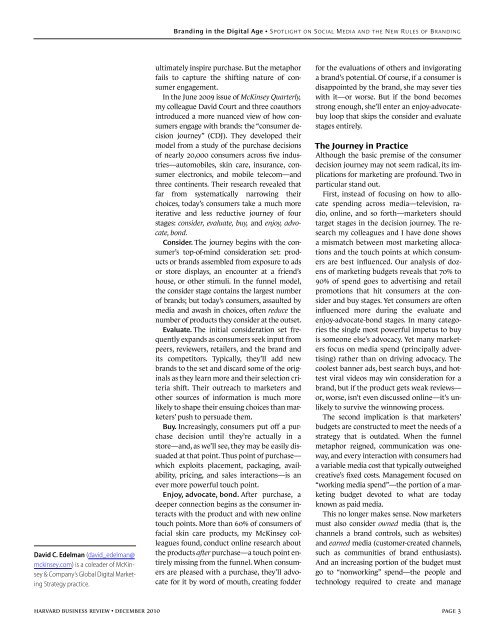Branding in the Digital Age - Edmar Bulla
Branding in the Digital Age - Edmar Bulla
Branding in the Digital Age - Edmar Bulla
You also want an ePaper? Increase the reach of your titles
YUMPU automatically turns print PDFs into web optimized ePapers that Google loves.
David C. Edelman<br />
(david_edelman@<br />
mck<strong>in</strong>sey.com) is a coleader of McK<strong>in</strong>sey<br />
& Company’s Global <strong>Digital</strong> Market<strong>in</strong>g<br />
Strategy practice.<br />
<strong>Brand<strong>in</strong>g</strong> <strong>in</strong> <strong>the</strong> <strong>Digital</strong> <strong>Age</strong>•••SPOTLIGHT<br />
ON SOCIAL<br />
MEDIA<br />
AND THE NEW<br />
RULES<br />
OF BRANDING<br />
ultimately <strong>in</strong>spire purchase. But <strong>the</strong> metaphor<br />
fails to capture <strong>the</strong> shift<strong>in</strong>g nature of consumer<br />
engagement.<br />
In <strong>the</strong> June 2009 issue of McK<strong>in</strong>sey Quarterly,<br />
my colleague David Court and three coauthors<br />
<strong>in</strong>troduced a more nuanced view of how consumers<br />
engage with brands: <strong>the</strong> “consumer decision<br />
journey” (CDJ). They developed <strong>the</strong>ir<br />
model from a study of <strong>the</strong> purchase decisions<br />
of nearly 20,000 consumers across five <strong>in</strong>dustries—automobiles,<br />
sk<strong>in</strong> care, <strong>in</strong>surance, consumer<br />
electronics, and mobile telecom—and<br />
three cont<strong>in</strong>ents. Their research revealed that<br />
far from systematically narrow<strong>in</strong>g <strong>the</strong>ir<br />
choices, today’s consumers take a much more<br />
iterative and less reductive journey of four<br />
stages: consider, evaluate, buy, and enjoy, advocate,<br />
bond.<br />
Consider. The journey beg<strong>in</strong>s with <strong>the</strong> consumer’s<br />
top-of-m<strong>in</strong>d consideration set: products<br />
or brands assembled from exposure to ads<br />
or store displays, an encounter at a friend’s<br />
house, or o<strong>the</strong>r stimuli. In <strong>the</strong> funnel model,<br />
<strong>the</strong> consider stage conta<strong>in</strong>s <strong>the</strong> largest number<br />
of brands; but today’s consumers, assaulted by<br />
media and awash <strong>in</strong> choices, often reduce <strong>the</strong><br />
number of products <strong>the</strong>y consider at <strong>the</strong> outset.<br />
Evaluate. The <strong>in</strong>itial consideration set frequently<br />
expands as consumers seek <strong>in</strong>put from<br />
peers, reviewers, retailers, and <strong>the</strong> brand and<br />
its competitors. Typically, <strong>the</strong>y’ll add new<br />
brands to <strong>the</strong> set and discard some of <strong>the</strong> orig<strong>in</strong>als<br />
as <strong>the</strong>y learn more and <strong>the</strong>ir selection criteria<br />
shift. Their outreach to marketers and<br />
o<strong>the</strong>r sources of <strong>in</strong>formation is much more<br />
likely to shape <strong>the</strong>ir ensu<strong>in</strong>g choices than marketers’<br />
push to persuade <strong>the</strong>m.<br />
Buy. Increas<strong>in</strong>gly, consumers put off a purchase<br />
decision until <strong>the</strong>y’re actually <strong>in</strong> a<br />
store—and, as we’ll see, <strong>the</strong>y may be easily dissuaded<br />
at that po<strong>in</strong>t. Thus po<strong>in</strong>t of purchase—<br />
which exploits placement, packag<strong>in</strong>g, availability,<br />
pric<strong>in</strong>g, and sales <strong>in</strong>teractions—is an<br />
ever more powerful touch po<strong>in</strong>t.<br />
Enjoy, advocate, bond. After purchase, a<br />
deeper connection beg<strong>in</strong>s as <strong>the</strong> consumer <strong>in</strong>teracts<br />
with <strong>the</strong> product and with new onl<strong>in</strong>e<br />
touch po<strong>in</strong>ts. More than 60% of consumers of<br />
facial sk<strong>in</strong> care products, my McK<strong>in</strong>sey colleagues<br />
found, conduct onl<strong>in</strong>e research about<br />
<strong>the</strong> products after purchase—a touch po<strong>in</strong>t entirely<br />
miss<strong>in</strong>g from <strong>the</strong> funnel. When consumers<br />
are pleased with a purchase, <strong>the</strong>y’ll advocate<br />
for it by word of mouth, creat<strong>in</strong>g fodder<br />
for <strong>the</strong> evaluations of o<strong>the</strong>rs and <strong>in</strong>vigorat<strong>in</strong>g<br />
a brand’s potential. Of course, if a consumer is<br />
disappo<strong>in</strong>ted by <strong>the</strong> brand, she may sever ties<br />
with it—or worse. But if <strong>the</strong> bond becomes<br />
strong enough, she’ll enter an enjoy-advocatebuy<br />
loop that skips <strong>the</strong> consider and evaluate<br />
stages entirely.<br />
The Journey <strong>in</strong> Practice<br />
Although <strong>the</strong> basic premise of <strong>the</strong> consumer<br />
decision journey may not seem radical, its implications<br />
for market<strong>in</strong>g are profound. Two <strong>in</strong><br />
particular stand out.<br />
First, <strong>in</strong>stead of focus<strong>in</strong>g on how to allocate<br />
spend<strong>in</strong>g across media—television, radio,<br />
onl<strong>in</strong>e, and so forth—marketers should<br />
target stages <strong>in</strong> <strong>the</strong> decision journey. The research<br />
my colleagues and I have done shows<br />
a mismatch between most market<strong>in</strong>g allocations<br />
and <strong>the</strong> touch po<strong>in</strong>ts at which consumers<br />
are best <strong>in</strong>fluenced. Our analysis of dozens<br />
of market<strong>in</strong>g budgets reveals that 70% to<br />
90% of spend goes to advertis<strong>in</strong>g and retail<br />
promotions that hit consumers at <strong>the</strong> consider<br />
and buy stages. Yet consumers are often<br />
<strong>in</strong>fluenced more dur<strong>in</strong>g <strong>the</strong> evaluate and<br />
enjoy-advocate-bond stages. In many categories<br />
<strong>the</strong> s<strong>in</strong>gle most powerful impetus to buy<br />
is someone else’s advocacy. Yet many marketers<br />
focus on media spend (pr<strong>in</strong>cipally advertis<strong>in</strong>g)<br />
ra<strong>the</strong>r than on driv<strong>in</strong>g advocacy. The<br />
coolest banner ads, best search buys, and hottest<br />
viral videos may w<strong>in</strong> consideration for a<br />
brand, but if <strong>the</strong> product gets weak reviews—<br />
or, worse, isn’t even discussed onl<strong>in</strong>e—it’s unlikely<br />
to survive <strong>the</strong> w<strong>in</strong>now<strong>in</strong>g process.<br />
The second implication is that marketers’<br />
budgets are constructed to meet <strong>the</strong> needs of a<br />
strategy that is outdated. When <strong>the</strong> funnel<br />
metaphor reigned, communication was oneway,<br />
and every <strong>in</strong>teraction with consumers had<br />
a variable media cost that typically outweighed<br />
creative’s fixed costs. Management focused on<br />
“work<strong>in</strong>g media spend”—<strong>the</strong> portion of a market<strong>in</strong>g<br />
budget devoted to what are today<br />
known as paid media.<br />
This no longer makes sense. Now marketers<br />
must also consider owned media (that is, <strong>the</strong><br />
channels a brand controls, such as websites)<br />
and earned media (customer-created channels,<br />
such as communities of brand enthusiasts).<br />
And an <strong>in</strong>creas<strong>in</strong>g portion of <strong>the</strong> budget must<br />
go to “nonwork<strong>in</strong>g” spend—<strong>the</strong> people and<br />
technology required to create and manage<br />
harvard bus<strong>in</strong>ess review • december 2010 page 3


